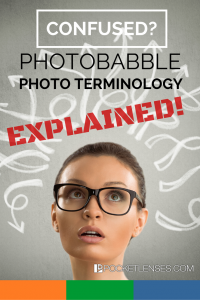 Understand Photo Terms
Understand Photo Terms
Acronyms, initialisms, photo terminology and other camera gobbledygook that you should know about, but were too afraid to ask.
Knowledge is power and if you understand photo terms such as EVF, OVF, RAW, JPEG, VR, IS, and USM you can make better decisions and choices regarding your photography.
This’ll be my first stab at a PhotoBabble Translation Article, defining photo terminology for you. I will be adding these definitions to a static PhotoBabble Translation PAGE as I write more articles. Let me know if there is any photo terminology you’d like me to define and check the PhotoBabble Page for new Babbles every so often.
Instead of organizing the definition list by a boring traditional alphabetic convention, I’m going to use a slightly unconventional method: However I feel like organizing the list. Here’s why: I often get asked to define photography terms not alphabetically, but usually by what they want to know right now. So, below is the list of terms that I get asked about most often. It is also the same terms that generate the rolled eyes, blanks stares or yawns I often see when I excitedly begin waxing philosophical about all things photographic.
Okay, let’s do this:
ISO
The setting that determines how light sensitive your image sensor is. Low numbers (i.e. 100, 150, 200) need MORE light to get a properly exposed picture. High numbers (i.e. 1600, 3200) require less light BUT pictures can be “noisy” or grainy. ISO 100 is fine outside on a bright sunny day. Step into a dim room and you’ll have to “pump up the ISO” to compensate for the lower light. Use the lowest ISO number that you can. You can control your ISO setting or you can let your camera do so.
F-STOP or Aperture (same thing)
Your lens has a built-in mechanism that can let in more or less light. “Sort of” like opening or closing window blinds (not really, but close enough) to regulate light. Hang on, this next bit is sometimes confusing and counterintuitive. The smaller the number (i.e. 1.4, 1.8, 2.0) the BIGGER the hole. The higher the number (i.e. 16, 22) the SMALLER the hole. … see? I told you … SO if you want to let in MORE light you need to decrease your f-stop number and if you want to let in LESS light you need to increase your f-stop number. I know, annoying, but that’s just how it is. Just deal with it. You can control your aperture setting or you can let your camera do so.
Shutter Speed
How fast your camera “blinks” open to let in light. “Usually” expressed in fractions of a second. A shutter speed of ¼ is faster than a shutter speed of ½. A shutter speed of 1/250 is pretty fast and 1/1600 will usually freeze motion on most fast moving objects (sports, etc.) You can control your shutter speed setting or you can let your camera do so.
The above 3 things (ISO, Aperture and Shutter Speed) are super important and are what make up what is known as the “Exposure Triangle” … more on this another time. I can see your eyes starting to glaze over.
Aperture Priority Mode: Means you set the size of your aperture and the camera can take care of the rest (i.e. ISO and Shutter Speed are camera controlled). This is my most often “go to” or default mode.
Shutter Speed Priority Mode: Means you set the speed of the shutter and the camera can take care of the rest (i.e. ISO and Aperture are camera controlled). I’ll shoot in this mode if I want to intentionally keep my shutter fast (i.e. shooting sports) or slow (i.e. long exposures).
Manual Mode: Means you take control of all 3 aspects. It takes a bit of practice, but this where you REALLY take control of your images and are not simply accepting what your camera “thinks” is right. This is my second most used mode.
 Full Auto: Means the camera decides everything for you. You point, take the shot and hope that the camera made the right decisions (about a great many things). I hardly ever shoot in this mode any longer. It’s a good place to start, but learning how to use the other modes can really open up your photography. Use this method in an emergency if you’re not sure what to do and need to act quickly to snap that photo of Bigfoot in your campsite or of E.T. doing a flyby on a bike.
Full Auto: Means the camera decides everything for you. You point, take the shot and hope that the camera made the right decisions (about a great many things). I hardly ever shoot in this mode any longer. It’s a good place to start, but learning how to use the other modes can really open up your photography. Use this method in an emergency if you’re not sure what to do and need to act quickly to snap that photo of Bigfoot in your campsite or of E.T. doing a flyby on a bike.
Viewfinder:
The thing you stick your eye right up against to peep through and see what you’re shooting at.
OVF: This is an Optical viewfinder. This uses lenses and/or mirrors to allow you to see what you are taking a picture of. Sort of like looking through binoculars or a telescope.
EVF: What you see when you peep through the eyepiece is actually a teeny, tiny screen, much like the one on the back of most cameras … only … tiny. These used to be of questionable quality, but have gotten much better over time. It gives you a nice way to “really” see what your camera sensor is seeing before you take the shot.
LCD Screen on the back of the camera. Sometime they are touch sensitive. Some are designed to be seen from wide angles or even in bright light. Comes in different sizes. Some swivel, tilt and do the boogaloo.
WiFi
Wireless technology that might (depending on the available features of your camera) allow you to: Send pictures to your computer or mobile device, control your camera (i.e. take pictures using your smartphone to trigger) and in some cases post to the Internet (i.e. email or Facebook) directly from your camera.
Sensor Sizes
Inside every digital camera is an image sensor. Some are large, some are tiny. Usually the bigger the better, but newer technology has been able to create amazing images from smaller sensors.
Full Frame: Generally considered the largest size sensor that “most” people will use. (An image sensor that is even larger is called medium format. Why is something called “Full Frame” larger than something called “Medium Format”? I could explain, but … I won’t right now. Just deal with it. It’s how it is.) Full Frame is found in higher level SLR (read “pro”) cameras. Not “typically” found in smaller cameras but some high end compacts do have them!
APS-C: Smaller than full frame, but still pretty large. Used in many pro and consumer level SLR cameras and some compact cameras.
Four Thirds: Smaller than APS-C. A term used by Olympus and Panasonic.
⅔ inch: Smaller than Four Thirds. Found on some compacts.
Sensor sizes smaller than ⅔ are quite small and found in “point and shoots”. Small sensors allow for very small cameras (i.e. tiny pocket cameras, smartphones, etc.) but have the disadvantage that they are not large enough to collect enough light in dim situations well. This factor, combined with teeny tiny lenses, is the limitation of small cameras.
Steady as she goes!
IS or VR (the same thing with different letters)
Image Stabilization or Vibration Reduction or Anti Shake or “Hey help me stop shaking my lens so that my images are clearer!” This is technology built in to a lens or camera body that will “smooth”out the shakes and help keep your image steady for you to take a shot. A nice feature than can really help with long telephoto lenses or for those times you’ve tried to take pictures after having your 5th caramel macchiato triple shot.
Edit your photos online for FREE!



This was very helpful I had no idea what 90% of these terms and acronyms were. I now feel like I can carry on a somewhat intelligent conversation with a photographer.
I’ve just been guessing about these acronyms. It’s sure is nice to finally know what they all mean. Thank you!
Thanks for making that so compact and simpler than any other article I have seen! I admit that I still find some of those things confusing so would love to know more!